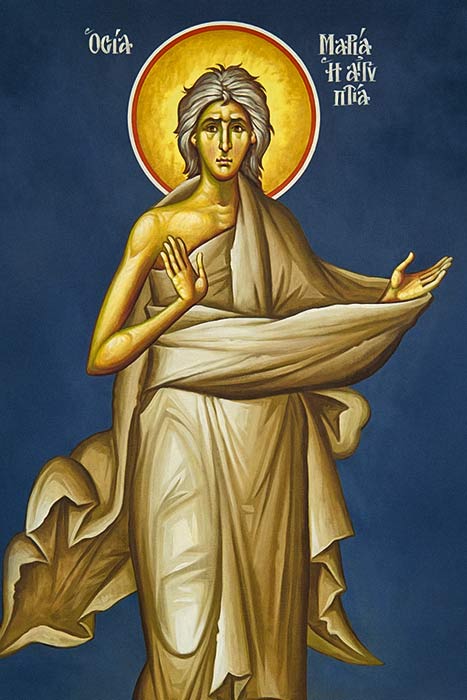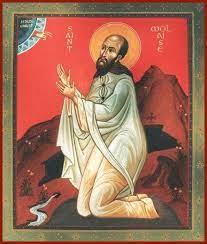A daily study of the Network’s diverse faiths

Sunday of St Mary of Egypt (Ϯⲁⲅⲓⲁ Ⲙⲁⲣⲓⲁ Ⲛⲣⲉⲙⲛ̀ⲭⲏⲙⲓ) (c 344-c421). The Fifth Sunday of Orthodox Great Lent is, due to her recognition by the Church as a model of repentance, dedicated to the commemoration of the Righteous Mother Mary of Egypt, whose Life is read on the previous Thursday during the Great Canon of St Andrew of Crete. Many churches celebrate a Blessing of Dried Fruit in commemoration of St Mary’s profound asceticism. The Holy Mother Mary was born in Egypt, left home at 12 and spent 17 years in debauchery, living from charity and linen-weaving. She went to the Church of the Resurrection in Jerusalem on the day of the Exaltation of the Cross but an invisible force prevented her from entering, due to the impurity of her life. She prayed to an icon of the Mother of God: “O Sovereign Lady, who didst bear God in the flesh, I know that I should not dare to look upon thine icon, thou who are pure in soul and body, because, debauched as I am, I must fill thee with disgust. But, as the God born of thee became Man in order to call sinners to repentance, come to my aid! Allow me to go into the church and prostrate before His Cross. And, as soon as I have seen the Cross, I promise that I will renounce the world and all pleasures and follow the path of salvation that thou willest to show me.” Thus freed, she entered the church, where a voice said from on high: “If you cross the Jordan, you will find rest.” Going to the Jordan, she crossed and lived on herbs and wild roots as a Desert Mother for 47 solitary years. From the hardened sinner that she had been, Mary has for a great many souls crushed under the burden of sin become a source of hope and a model of conversion, an encouragement for all who have neglected their salvation proclaiming what repentance can bring them. Venerated in Orthodox and Coptic Churches. Feast Day 1 April. Patron of penitents in the Roman Catholic Church. Image: © 2017 Greek Orthodox Archdiocese of America.
Prayer In you the image was preserved with exactness, O Mother. You took up your cross, followed Christ and by your deeds taught us to overlook the flesh that passes away and attend to the soul since it is immortal. O righteous Mary, having escaped the gloom of sin and shining brightly with the light of repentance, thou didst present thy heart to Christ. Amen

Guru Angad Dev Ji (ਗੁਰੂ ਅੰਗਦ , Lehna) (1504-52). Celebration of birth of Lehna, a Panjabi Hindu Khatri who at 16 married a Khatri girl and, before becoming a Sikh renamed Angad, was a religious teacher and priest performing services to Durga (दुर्गा), one of the principal Hindu deities and goddess of war, strength and protection. The helpful Bhai (Brother) Lehna was chosen by Guru Nanak, the founder of Sikhism, over his own fastidious sons as his successor as 2nd of the 10 gurus. After the 1539 death of Guru Nanak, a sad Angad retired to a disciple’s house where another early Sikh, Baba Buddha, later found him and asked him to return for Guruship. The Gurbani (hymn) of the time: “Die before the one whom you love, to live after he dies is to live a worthless life in this world” was the 1st hymn by Guru Angad in Guru Granth Sahib (ਗੁਰੂ ਗ੍ਰੰਥ ਸਾਹਿਬ), the primary religious scripture of Sikhism, and signifies the pain he felt upon separation from Guru Nanak. Guru Angad focussed on teaching children and building the community through charitable works such as langars (free community kitchens in Sikh Gurdwaras). He also set the rules and training method for the volunteers (sevadars) who operated the kitchen, placing emphasis on treating it as a place of rest and refuge and always being polite and hospitable to all visitors. Guru Angad began the process of collecting the Saloks (Compositions) of Guru Nanak, contributed over 60 of his own and started a vernacular Punjabi literature. Before his death, following the example set by Guru Nanak, Guru Angad nominated, over his own sons, as his successor and 3rd Nanak the faithful Guru Amar Das, who had been a Vaishnava Hindu. Guru Angad is credited with improving the Gurmukhi (ਗੁਰਮੁਖੀ, گُرمُکھی) script, now the standard script for Punjabi writing in India in contrast to Pakistan where the Arabic script Nastaliq is standard. The original Sikh scriptures and most of the historic Sikh literature are in the Gurmukhi script. Guru Angad was a great patron of wrestling and started a Mall Akhara (wrestling arena) system where daily physical exercise, games, martial arts and wrestling after daily prayers were taught with health topics such as avoiding tobacco and other toxic substances. Image: www.sikh-heritage.co.uk

St Molaise of Leighlin (Laisrén) (dc639). Feast Day commemorating death of Irish monk, raised in Scotland, who lived as a hermit in a cave that bears his name on Holy Isle in the Firth of Clyde. On a pilgrimage to Rome, he was ordained Bishop before becoming Abbot of the Irish monastery of Old Leighlin (Leithglenn) in County Carlow. He modified Church discipline in accordance with the practices of Rome and is depicted in the extant fragment of the Old Irish prose narrative The Vision of Laisrén, one of the earliest vernacular pieces of vision literature in the Christian tradition, as leaving the monastery of Clúain (Cloyne) to purify the local Connaught church. After a 3-night fast, his soul was taken to Hell by 2 angels who showed him the horrors that awaited unredeemed sinners and the angels told a devil eager to take Laisrén from them that their guest was granted the vision as a warning to his friends. In a note added to the 9th Century Félire Óengusso (Martyrology of Óengus), Molaise is said to have taken a hair from St Sillán’s eyebrow that caused anyone seeing it in the morning to immediately die, a fate he suffered but from which he had saved others. Because of the connection between lasair (flame) and sunrise, Molaise’s name has been interpreted as relating to solar mythology. His monastery thrived and gave its name to the 1111 Irish national church council Synod of Ráith Bressail. The Old Leighlin St Laserian’s Holy Well is now dry but on St Leighlin’s Feast Day people would go to the well after mass to pray and drink the water. The well site to the west of Old Leighlin Cathedral has been carefully enclosed and is still venerated with its old granite wheeled cross with edge moulding and standing 1.27 m high and 0.6 metres wide in a granite base set on a modern plinth. Venerated in Scotland, Roman Catholic Church, Eastern Orthodox Church, Anglican Communion (Church of Ireland). Image: aidanharticons.com.
